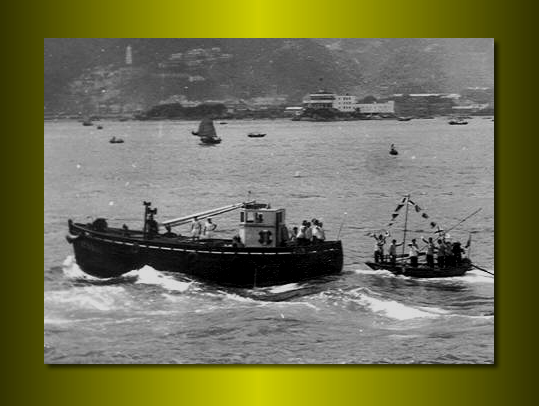 |
 |
|
Jenny's
Side Party |
Courtesy
Bernard Beare |
|
For
any sailor from Britain, or the Commonwealth, who served in the Far East,
Jenny & her side party were the stuff of legend. The speed & efficiency
with which her team of 'girls' could paint a warship from stem to stern
was simply amazing.
JENNY, BEM. Generations of sailors who visited Hong Kong will mourn the death of Jenny. She was a much loved figure and an incomparable institution for well over half a century. She died peacefully on 18 February 2009 at the age of 92. Much of her life was an enigma. However, the authors of her twenty-seven Certificates of Service generally agreed that she was born in a sampan in Causeway Bay in 1917. Her mother, Jenny One, according to her one surviving Certificate of Service, which was copied in 1946 from an older, much battered and largely illegible document., 'provided serviceable sampans far the general use of the Royal Navy, obtained sand, and, was useful for changing money’. Behind her perpetual great gold-toothed grin Jenny complained; “I velly chocker. All time work in sampan. N0 learn to lead or lite.” But what she lacked in education she made up more than a hundredfold with her immense and impressive experience in ship husbandry, her unfailing thoroughness and apparently inexhaustible energy. Her unquestionable loyalty and integrity, her infectious enthusiasm and her innate cheerfulness. Officially Jenny's Date of Volunteering was recorded as 1928. From then until 1997, when the colony became a Special Administrative Region of China and the Royal Navy moved out, she and her team of tireless girls, who at one time numbered nearly three dozen, unofficially served the Royal and Commonwealth Navies in Hong Kong by cleaning and painting their ships. Attending their buoy jumpers, and, dressed in their best, waiting with grace and charm upon their guests at cocktail parties. Captains and Executive Officers would find fresh flowers in their cabins and newspapers delivered daily, and many a departing officer received a generous gift as a memento from Jenny. For all of this she steadfastly refused ever to take any payment. Instead she and her Side Party earned their keep selling soft drinks to the ships' companies and accepting any item of scrap which could be found on board. Jenny's huge collection of photographs - too big. she said. to be put into books - she stored in a large envelope. They dated back to the mid 20th century and showed her in the ships she so faithfully served, with Buffers and Side Parties, and with grateful officers, many of whom became distinguished admirals. In two thick albums she proudly kept her letters of reference, all without exception filled with praise and affection for her. One was a commendation by the Duke of Edinburgh for her work in the Royal Yacht during her visit to Hong Kong in 1959. She had a Long Service and Good Conduct Medal presented to her in 1938 by the captain of the heavy cruiser HMS DEVONSHIRE, and a bar from the frigate HMS LEANDER in 1975. Most treasured of all Jenny's distinctions was the British Empire Medal awarded her in the Hong Kong Civilian List of the Queen's Birthday Honours in 1980 and with which, under her formal name Mrs. Ng Muk Kah, she was invested by the Governor of Hong Kong, Sir Murray MacLehose. In
later years Hong Kong was no longer visited by the great fleets of warships
which gave Jenny and her Side Party their livelihood and she found it
increasingly difficult to make ends meet. Yet she stayed fit and always
willing to undertake any work available. To the end of the Royal Navy's
presence in Hong Kong there could be seen in the shadow of the towering
Prince of Wales building within the naval base, a small round figure
in traditional baggy black trousers and high-collared smock, with a
long pigtail and eternal smile who, regardless of time, remained it
seemed for ever – just Jenny. Jenny's Side Party. On arrival in Hong Kong Jenny's side party were permitted to attach themselves to HMS London. They came highly recommended by Belfast and a number of other ships in the Far Eastern Fleet. The girls were very popular and adept with a paint brush. Their pay consisted of spare food, bits of rope, tin, bottles, in fact anything that would usually have been jettisoned overboard.
With Mount Victoria in the background Jenny's girls supervise 'painting ship'.
When
it was finally time to go home the girls turned out in force in their
sampan to wave the ships company goodbye. 
|